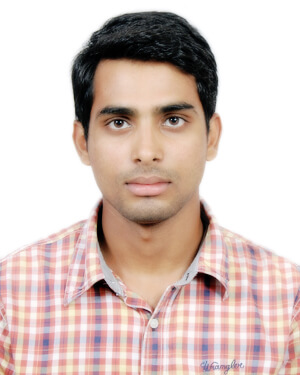How does Human Papillomavirus infection drive host oncogene over-expression in cervical cancer?
Work done in the lab of Dr. Sabarinathan Radhakrishnan at NCBS, Bangalore.
Anurag Kumar Singh is an Integrated PhD student in the computational cancer genomics lab at NCBS, Bangalore. He enjoys exploring genomics data to find patterns which influence cancer evolution.

Author Interview
How would you explain your research outcomes to the non-scientific community?
Human papillomavirus (HPV) is the major driving agent behind cervical cancer cases worldwide. The HPV genome has oncogenes (onko in Greek means “lump”) encoded within itself, which as the name suggests can lead to oncogenesis i.e. cancer formation. In addition, HPV DNA is usually found integrated into the host human genome in cervical cancers. Although the oncogenic role of genes expressed from HPV DNA is well studied, the impact of HPV integration itself on the host chromatin structure and associated gene expression changes is not well understood. By using data from a large number of cervical cancer patients, we show that HPV integrations can dysregulate host gene expression in its vicinity as well as at large distances. An important question in the field has been how far HPV integrations can perturb host gene expression. We show that the structural organisation of host DNA determines the expanse of the long-distance dysregulation of host gene expression by HPV integration. Especially host oncogenes were overexpressed in the presence of HPV integrations, which could favour the oncogenesis.

“Our findings suggest the existence of multiple HPV-driven processes towards cervical oncogenesis.”
How do these findings contribute to your research area?
Our findings suggest the existence of multiple HPV-driven processes towards cervical oncogenesis. It was widely believed that viral oncogenes are the primary driver for cervical cancers, with a limited role for HPV integrations. Our findings show that HPV integrations could have a much bigger role in carcinogenesis by not only dysregulating the host gene expression near the integration but also the host oncogenes present far away from the integration facilitated by the host chromatin structure. Thus there is a synergistic role of HPV oncogenes and HPV integration towards carcinogenesis. Also, HPV integrations in specific regions seem to be more important for cervical cancer progression. This could be used in future to predict cancer progression. Following this we are trying to expand these results in the Indian cervical cancers and other cancers driven by HPV.
What was the exciting moment during your research?
I still remember the time when we were trying to figure out if the host genome organisation influences the extent of HPV integration-induced host gene expression dysregulation. When we found that our hunch was right, and it did have a huge effect, that particular moment was quite exciting. I would also like to add that scientific research is a journey of gradual progress, akin to step-by-step growth. Every analysis or experiment and the results it produces have its own emotions associated with it. You learn something every day, so I would say the whole journey has been quite thrilling.
What do you hope to do next?
I plan to go for post-doctoral training in computational cancer research, wherein I aim to better understand the driving forces behind different types of cancer. I want to use my research to contribute to clinical practices and help patients.
Where do you seek scientific inspiration from?
I always look up to the leaders in the field and how they address challenging scientific questions in innovative ways. Their constant urge to make fundamental discoveries is something I have always appreciated. My mentors, Dr Sabari and Dr Dimple, have always encouraged open discussion on diverse ideas which have improved my scientific thought process. Apart from this, I have enjoyed wide-ranging discussions with my labmates and other colleagues about their scientific journey, the challenges associated with it and how they overcame them. Understanding this humane side of science is certainly encouraging and has been very enriching for me.
How do you intend to help Indian science improve?
I have always enjoyed teaching. I believe fostering a scientific attitude in undergraduate and school-level education would provide students with much-required exposure to future opportunities and challenges in scientific research. Last year, I contributed to the undergraduate lecture series at NCBS, educating college students about active research areas in biological sciences. I have also had the opportunity to teach in more advanced and technical workshops related to genomics. As a scientific discipline, genomics has huge potential to improve healthcare and medicine, which is still underutilised in the Indian context. Looking ahead, I plan to engage in more teaching opportunities across India.
Reference:
Singh, A. K., Walavalkar, K., Tavernari, D., Ciriello, G., Notani, D., & Sabarinathan, R. (2023). Cis-regulatory effect of HPV integration is constrained by host chromatin architecture in cervical cancers. Molecular Oncology. https://doi.org/10.1002/1878-0261.13559
Biopatrika: Bringing Science to Society
© Biopatrika 2024 All Rights Reserved.
